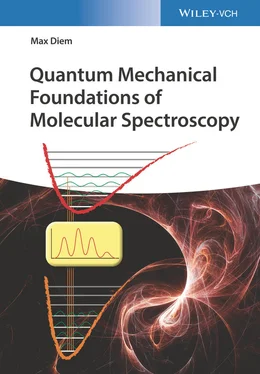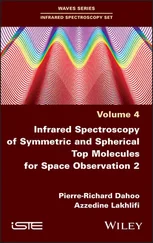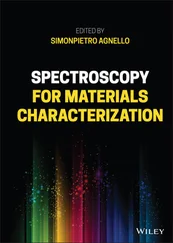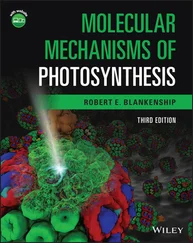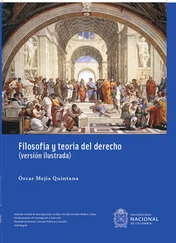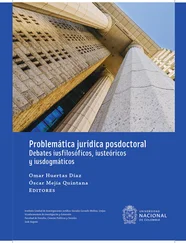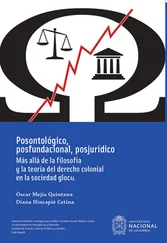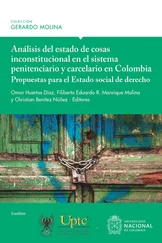1 Cover
2 Title Page Quantum Mechanical Foundations of Molecular Spectroscopy Max Diem
3 Copyright Author Max Diem, PhD Professor Emeritus Department of Chemistry Northeastern University Laboratory of Spectral Diagnosis Boston, MA USA Cover iStock 965444768 / © StationaryTraveller Supplementary material for instructors, including a Solution Manual, available for download from www.wiley-vch.de/textbooks All books published by WILEY‐VCH are carefully produced. Nevertheless, authors, editors, and publisher do not warrant the information contained in these books, including this book, to be free of errors. Readers are advised to keep in mind that statements, data, illustrations, procedural details or other items may inadvertently be inaccurate. Library of Congress Card No.: applied for British Library Cataloguing‐in‐Publication Data A catalogue record for this book is available from the British Library. Bibliographic information published by the Deutsche Nationalbibliothek The Deutsche Nationalbibliothek lists this publication in the Deutsche Nationalbibliografie; detailed bibliographic data are available on the Internet at < http://dnb.d-nb.de >. © 2021 WILEY‐VCH GmbH, Boschstr. 12, 69469 Weinheim, Germany All rights reserved (including those of translation into other languages). No part of this book may be reproduced in any form – by photoprinting, microfilm, or any other means – nor transmitted or translated into a machine language without written permission from the publishers. Registered names, trademarks, etc. used in this book, even when not specifically marked as such, are not to be considered unprotected by law. Print ISBN: 978‐3‐527‐34792‐6 ePDF ISBN: 978‐3‐527‐82961‐3 ePub ISBN: 978‐3‐527‐82960‐6 Cover Design SCHULZ Grafik‐Design, Fußgönheim, Germany
4 Preface
5 Introduction References
6 1 Transition from Classical Physics to Quantum Mechanics 1.1 Description of Light as an Electromagnetic Wave 1.2 Blackbody Radiation 1.3 The Photoelectric Effect 1.4 Hydrogen Atom Absorption and Emission Spectra 1.5 Molecular Spectroscopy 1.6 Summary References Problems
7 2 Principles of Quantum Mechanics 2.1 Postulates of Quantum Mechanics 2.2 The Potential Energy and Potential Functions 2.3 Demonstration of Quantum Mechanical Principles for a Simple, One‐Dimensional, One‐Electron Model System: The Particle in a Box 2.4 The Particle in a Two‐Dimensional Box, the Unbound Particle, and the Particle in a Box with Finite Energy Barriers 2.5 Real‐World PiBs: Conjugated Polyenes, Quantum Dots, and Quantum Cascade Lasers References Problems
8 3 Perturbation of Stationary States by Electromagnetic Radiation 3.1 Time‐Dependent Perturbation Treatment of Stationary‐State Systems by Electromagnetic Radiation 3.2 Dipole‐Allowed Absorption and Emission Transitions and Selection Rules for the Particle in a Box 3.3 Einstein Coefficients for the Absorption and Emission of Light 3.4 Lasers References Problems Note
9 4 The Harmonic Oscillator, a Model System for the Vibrations of Diatomic Molecules 4.1 Classical Description of a Vibrating Diatomic Model System 4.2 The Harmonic Oscillator Schrödinger Equation, Energy Eigenvalues, and Wavefunctions 4.3 The Transition Moment and Selection Rules for Absorption for the Harmonic Oscillator 4.4 The Anharmonic Oscillator 4.5 Vibrational Spectroscopy of Diatomic Molecules 4.6 Summary References Problems
10 5 Vibrational Infrared and Raman Spectroscopy of Polyatomic Molecules 5.1 Vibrational Energy of Polyatomic Molecules: Normal Coordinates and Normal Modes of Vibration 5.2 Quantum Mechanical Description of Molecular Vibrations in Polyatomic Molecules 5.3 Infrared Absorption Spectroscopy 5.4 Raman Spectroscopy 5.5 Selection Rules for IR and Raman Spectroscopy of Polyatomic Molecules 5.6 Relationship between Infrared and Raman Spectra: Chloroform 5.7 Summary: Molecular Vibrations in Science and Technology References Problems
11 6 Rotation of Molecules and Rotational Spectroscopy 6.1 Classical Rotational Energy of Diatomic and Polyatomic Molecules 6.2 Quantum Mechanical Description of the Angular Momentum Operator 6.3 The Rotational Schrödinger Equation, Eigenfunctions, and Rotational Energy Eigenvalues 6.4 Selection Rules for Rotational Transitions 6.5 Rotational Absorption (Microwave) Spectra 6.6 Rot–Vibrational Transitions References Problems
12 7 Atomic Structure: The Hydrogen Atom 7.1 The Hydrogen Atom Schrödinger Equation 7.2 Solutions of the Hydrogen Atom Schrödinger Equation 7.3 Dipole Allowed Transitions for the Hydrogen Atom 7.4 Discussion of the Hydrogen Atom Results 7.5 Electron Spin 7.6 Spatial Quantization of Angular Momentum References Problems Note
13 8 Nuclear Magnetic Resonance (NMR) Spectroscopy8.1 General Remarks 8.2 Review of Electron Angular Momentum and Spin Angular Momentum 8.3 Nuclear Spin8.4 Selection Rules, Transition Energies, Magnetization, and Spin State Population 8.5 Chemical Shift 8.6 Multispin Systems 8.7 Pulse FT NMR Spectroscopy References Problems
14 9 Atomic Structure: Multi‐electron Systems9.1 The Two‐electron Hamiltonian, Shielding, and Effective Nuclear Charge 9.2 The Pauli Principle 9.3 The Aufbau Principle 9.4 Periodic Properties of Elements 9.5 Atomic Energy Levels 9.6 Atomic Spectroscopy 9.7 Atomic Spectroscopy in Analytical Chemistry References Problems
15 10 Electronic States and Spectroscopy of Polyatomic Molecules 10.1 Molecular Orbitals and Chemical Bonding in the H 2 +Molecular Ion 10.2 Molecular Orbital Theory for Homonuclear Diatomic Molecules 10.3 Term Symbols and Selection Rules for Homonuclear Diatomic Molecules 10.4 Electronic Spectra of Diatomic Molecules 10.5 Qualitative Description of Electronic Spectra of Polyatomic Molecules 10.6 Fluorescence Spectroscopy10.7 Optical Activity: Electronic Circular Dichroism and Optical Rotation References Problems Note
16 11 Group Theory and Symmetry 11.1 Symmetry Operations and Symmetry Groups 11.2 Group Representations 11.3 Symmetry Representations of Molecular Vibrations 11.4 Symmetry‐Based Selection Rules for Dipole‐Allowed Processes 11.5 Selection Rules for Raman Scattering 11.6 Character Tables of a Few Common Point Groups References Problems
17 Appendix 1: Constants and Conversion Factors
18 Appendix 2: Approximative Methods: Variation and Perturbation TheoryA2.1 General Remarks A2.2 Variation Method A2.3 Time‐independent Perturbation Theory for Nondegenerate Systems A2.4 Detailed Example of Time‐independent Perturbation: The Particle in a Box with a Sloped Potential Function A2.5 Time‐dependent Perturbation of Molecular Systems by Electromagnetic Radiation Reference
19 Appendix 3: Nonlinear Spectroscopic Techniques A3.1 General Formulation of Nonlinear Effects A3.2 Noncoherent Nonlinear Effects: Hyper‐Raman Spectroscopy A3.3 Coherent Nonlinear Effects A3.4 Epilogue References
20 Appendix 4: Fourier Transform (FT) MethodologyA4.1 Introduction to Fourier Transform Spectroscopy A4.2 Data Representation in Different Domains A4.3 Fourier Series A4.4 Fourier Transform A4.5 Discrete and Fast Fourier Transform Algorithms A4.6 FT Implementation in EXCEL or MATLAB References
21 Appendix 5: Description of Spin Wavefunctions by Pauli Spin Matrices A5.1 The Formulation of Spin Eigenfunctions α and β as Vectors A5.2 Form of the Pauli Spin Matrices A5.3 Eigenvalues of the Spin Matrices Reference
22 Index
23 End User License Agreement
1 Chapter 1 Table 1.1 Photon energies and spectroscopic ranges a.
2 Chapter 5Table 5.1 Vibrational modes and assignments for chloroform, HCCl 3.
3 Chapter 8Table 8.1 Nuclear g ‐factors, magnetogyric ratios, and spin moments for some sp...
Читать дальше
